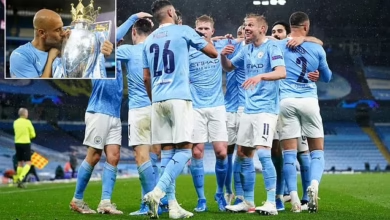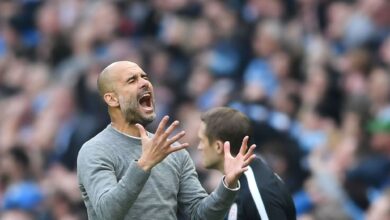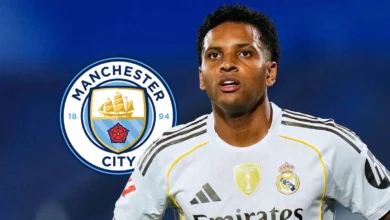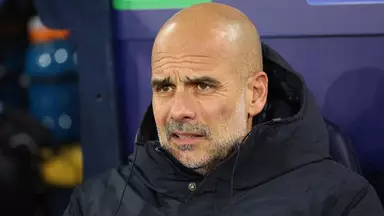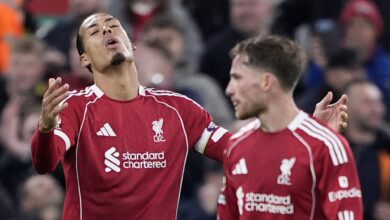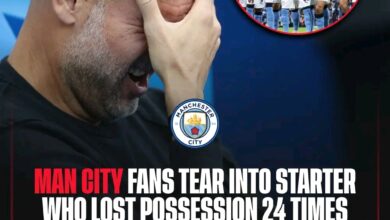Pep Guardiola should now tell Man City to sign ‘outstanding’ Thomas Frank target at Tottenham who loves Rodri
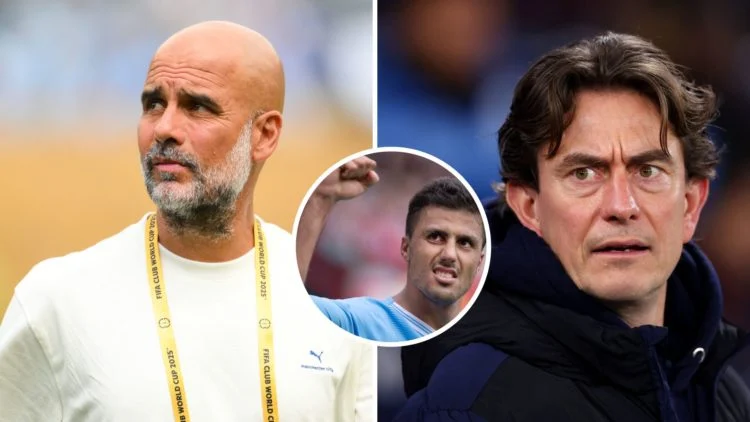
As the summer transfer window reaches its crescendo, Manchester City finds itself at a crucial juncture in their quest for continued dominance in English and European football. Under the meticulous guidance of Pep Guardiola, the Citizens have established themselves as the benchmark for modern football excellence, but maintaining this standard requires constant evolution and strategic investment in the transfer market.
The 2025 summer transfer window has already witnessed significant activity from the Etihad Stadium, with the club making calculated moves to address specific areas of their squad. However, as competitors like Tottenham Hotspur and Manchester United continue to strengthen their ranks, City’s recruitment team faces the challenge of staying ahead of the curve while maintaining their philosophical approach to player development and tactical innovation.
The Current Transfer Landscape: City’s Strategic Approach
Manchester City’s approach to the current transfer window reflects their long-term vision rather than short-term fixes. The acquisitions of Rayan Cherki and the strategic targeting of players like Tijjani Reijnders demonstrate Guardiola’s commitment to building a squad that can compete on multiple fronts while maintaining the technical excellence that has become synonymous with his tenure.
The club’s decision-making process has been particularly evident in their approach to the Morgan Gibbs-White situation. Despite Tottenham’s interest in the Nottingham Forest midfielder, City opted against matching the £70 million valuation, preferring instead to diversify their investment across multiple positions. This calculated restraint showcases the club’s financial discipline and strategic thinking, recognizing that sustainable success requires balanced squad building rather than marquee signings at any cost.
This philosophy aligns with Guardiola’s historical approach to team construction, where he has consistently prioritized players who can adapt to multiple tactical systems and contribute to the collective rather than individual stars who might disrupt the team’s harmony. The emphasis on technical ability, tactical intelligence, and adaptability remains central to City’s recruitment strategy.
Adam Wharton: The Emerging Midfield Maestro
Central to Manchester City’s summer transfer considerations is Crystal Palace’s Adam Wharton, a 21-year-old midfielder who has rapidly established himself as one of the most promising young talents in English football. The former Blackburn Rovers player represents everything that Guardiola values in a modern midfielder: technical proficiency, tactical awareness, and the ability to influence games from deep positions.
Wharton’s statistical profile over the past 365 days reveals a player who could seamlessly integrate into City’s system. His 7.31 progressive passes per 90 minutes demonstrate his ability to break lines and initiate attacks from deep positions, a crucial skill in Guardiola’s possession-based system. Additionally, his defensive contributions, with 2.32 tackles and 1.37 interceptions per 90 minutes, show his understanding of the modern midfielder’s dual responsibilities.
The young Englishman’s 4.03 shot-creating actions per 90 minutes highlight his creative influence, suggesting he possesses the vision and execution necessary to thrive in City’s intricate passing networks. These numbers become even more impressive when considering his age and the level of competition he has faced in the Premier League.
Perhaps most significantly, Wharton’s admiration for Rodri suggests a player who understands and appreciates the role he would be expected to fulfill at City. His recognition of the Spanish midfielder’s qualities indicates a tactical maturity beyond his years and suggests he would be receptive to learning from one of the world’s best players in his position.
The Rodri Factor: Succession Planning and Tactical Evolution
Rodri’s influence on Manchester City’s success cannot be overstated. The Spanish midfielder has evolved into arguably the world’s finest defensive midfielder, combining exceptional passing range with defensive tenacity and tactical intelligence. His recent Ballon d’Or triumph represents not just personal achievement but vindication of the deep-lying playmaker role in modern football.
However, Rodri’s recent ACL injury and subsequent recovery have highlighted the importance of having adequate cover and eventual succession planning. The 28-year-old’s performances at the FIFA Club World Cup, where he appeared “leggy and uncharacteristically sloppy in possession,” serve as a reminder that even the world’s best players are not immune to the physical demands of elite football.
Wharton’s potential arrival would provide City with both immediate cover and long-term succession planning. The young midfielder’s playing style, characterized by his ability to control tempo and distribute the ball effectively, mirrors many of Rodri’s qualities while potentially offering different dimensions to City’s play. His pace and energy could complement Rodri’s experience and tactical awareness, creating a formidable partnership in the heart of City’s midfield.
The strategic value of signing Wharton extends beyond mere squad depth. In an era where fixture congestion and physical demands continue to increase, having multiple players capable of performing at the highest level in crucial positions becomes essential for sustained success across multiple competitions.
Tottenham’s Challenge: The Competition for Wharton’s Signature
Tottenham Hotspur’s interest in Adam Wharton presents a significant challenge to Manchester City’s recruitment plans. Under the guidance of Thomas Frank, Spurs have demonstrated ambition in the transfer market, and their ability to offer immediate first-team opportunities could prove attractive to a young player eager to establish himself at the highest level.
The North London club’s approach to Wharton reflects their broader strategy of targeting young, technically gifted players who can develop within their system. From Wharton’s perspective, the guarantee of regular first-team football at Tottenham might outweigh the prestige and trophies associated with Manchester City, particularly given the competitive nature of City’s squad.
However, Manchester City’s advantages in this potential transfer battle are significant. The opportunity to work under Pep Guardiola, learn from world-class teammates like Rodri, and compete for the highest honors in football represents a unique developmental opportunity. The club’s track record of nurturing young talent and providing pathways to first-team success, as evidenced by players like Phil Foden and Rico Lewis, could prove decisive in attracting Wharton’s signature.
The financial aspects of any potential deal also favor City. While Crystal Palace’s reported £80 million asking price represents a significant investment, City’s financial resources and strategic planning capabilities position them well to structure a deal that satisfies all parties involved.
Crystal Palace’s Position: Valuation and Negotiation Strategy
Crystal Palace’s demanding £80 million for Adam Wharton reflects both the player’s exceptional talent and the modern transfer market’s inflation. The Eagles’ position is strengthened by Wharton’s age, contract situation, and the interest from multiple top-tier clubs, creating a competitive environment that naturally drives up his valuation.
From Palace’s perspective, losing Wharton would represent a significant blow to their squad and future planning. The midfielder has become integral to their tactical approach, and his departure would necessitate substantial investment in replacement options. The high asking price serves both as a deterrent to potential suitors and as insurance that any eventual sale would provide adequate resources for squad rebuilding.
The negotiation dynamics surrounding Wharton’s potential transfer illustrate the complex relationships between clubs in the modern transfer market. Palace’s position as a selling club gives them leverage in negotiations, but the financial power of clubs like Manchester City and the appeal of Champions League football create pressures that are difficult to resist.
The Broader Midfield Restructuring at Manchester City
Manchester City’s interest in Adam Wharton must be understood within the context of their broader midfield restructuring plans. The potential departure of Nico Gonzalez, as reported by Manchester City News, would create additional space in the squad for new additions while potentially providing funds for new acquisitions.
The aging profiles of key midfielders like Mateo Kovacic, Bernardo Silva, and Ilkay Gundogan present both challenges and opportunities for squad planning. While these players continue to contribute at the highest level, their advancing years and the physical demands of Guardiola’s system suggest the need for younger alternatives who can provide energy and longevity.
Wharton’s potential arrival would address multiple concerns simultaneously. His youth and physicality would inject pace and power into City’s midfield, while his technical abilities would maintain the club’s high standards of ball retention and distribution. The description of Wharton as “outstanding” by Declan Rice, himself a player of exceptional quality, provides additional validation of the young midfielder’s potential.
The strategic importance of this potential signing extends beyond immediate tactical considerations. In an era where squad depth and rotation are crucial for success across multiple competitions, having players capable of performing at the highest level in various roles becomes essential. Wharton’s versatility and adaptability would provide Guardiola with additional tactical options and the flexibility to respond to different opponents and situations.
Wesley: The Brazilian Connection and Transfer Dynamics
The simultaneous pursuit of Wesley from Flamengo adds another dimension to Manchester City’s summer transfer strategy. The Brazilian midfielder’s situation, with Roma appearing close to securing his signature before City’s late intervention, illustrates the competitive nature of the modern transfer market and the importance of decisive action.
Pep Guardiola’s personal request for Wesley’s signing demonstrates the coach’s direct involvement in recruitment decisions and his confidence in the player’s potential contribution to the squad. The fact that Wesley has already reportedly agreed personal terms with Roma suggests that City’s late interest represents a significant change in their transfer priorities.
The pursuit of Wesley also highlights the global nature of Manchester City’s recruitment network and their ability to identify and pursue talent from diverse markets. The Brazilian’s potential arrival would add cultural diversity to the squad while providing different tactical options compared to more traditional European midfielders.
The timing of City’s interest in Wesley, coinciding with their pursuit of Wharton, suggests a comprehensive midfield overhaul that addresses both immediate needs and long-term planning. The combination of youth, experience, and international diversity would create a midfield department capable of competing at the highest level for years to come.
Financial Implications and Strategic Investment
The financial implications of Manchester City’s transfer activities must be considered within the context of Financial Fair Play regulations and sustainable club management. The combined cost of pursuing players like Wharton and Wesley would represent significant investment, but one that aligns with the club’s long-term strategic goals.
The comparison to Manchester City’s £77.6 million investment in Josko Gvardiol provides a useful precedent for evaluating the potential value of similar expenditure on midfield reinforcements. Gvardiol’s successful integration into the squad and his contribution to the team’s defensive solidity demonstrate that substantial investments in the right players can yield significant returns.
The economic benefits of successful transfers extend beyond immediate on-field contributions. The development of young players like Wharton could result in significant asset appreciation, while their contributions to team success generate revenue through prize money, commercial opportunities, and enhanced global profile.
Conclusion: The Path Forward for Manchester City
Manchester City’s summer transfer window activities reflect a club that continues to evolve and adapt to the changing demands of elite football. The pursuit of players like Adam Wharton and Wesley demonstrates both immediate tactical needs and long-term strategic planning, embodying the comprehensive approach that has made City one of the world’s most successful clubs.
The competition for Wharton’s signature with Tottenham and the late intervention in Wesley’s potential move to Roma illustrate the dynamic nature of the modern transfer market. Success in these negotiations would not only strengthen City’s squad but also demonstrate their continued ability to attract the world’s best emerging talent.
As the summer transfer window progresses, Manchester City’s ability to secure their priority targets will significantly influence their prospects for the upcoming season. The combination of experienced stars, emerging talents, and strategic investments positions the club well for continued success, but the execution of these transfer plans remains crucial for maintaining their position at the pinnacle of world football.
The coming weeks will determine whether City can successfully navigate the complexities of the transfer market to secure the players they need for continued success. The stakes are high, but the club’s track record of strategic planning and successful recruitment provides reason for optimism among supporters and stakeholders alike.







